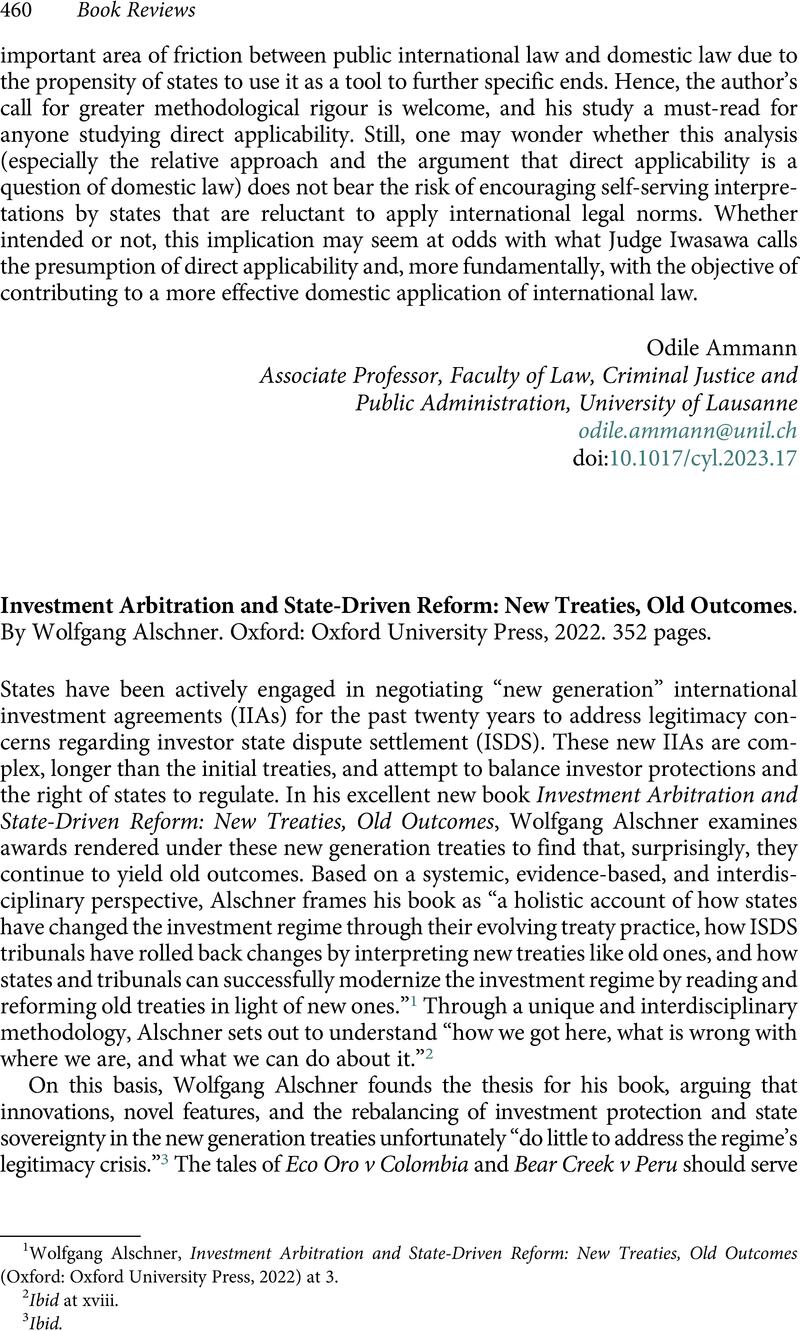No CrossRef data available.
Article contents
Investment Arbitration and State-Driven Reform: New Treaties, Old Outcomes. By Wolfgang Alschner. Oxford: Oxford University Press, 2022. 352 pages.
Review products
Published online by Cambridge University Press: 21 November 2023
Abstract

- Type
- Book Reviews/Recensions de livres
- Information
- Canadian Yearbook of International Law/Annuaire canadien de droit international , Volume 60 , November 2023 , pp. 460 - 466
- Copyright
- © The Canadian Yearbook of International Law/Annuaire canadien de droit international 2023
References
1 Alschner, Wolfgang, Investment Arbitration and State-Driven Reform: New Treaties, Old Outcomes (Oxford: Oxford University Press, 2022) at 3.Google Scholar
2 Ibid at xviii.
3 Ibid.
4 Copper Mesa Mining Corporation v Republic of Ecuador, PCA No 2012-2, Award (15 March 2016) at paras 6.58–6.67; Bear Creek Mining Corporation v Republic of Peru, ICSID Case No ARB/14/ 21, Award (30 November 2017) at paras 459–74.
5 Alschner, supra note 1 at 7.
6 Ibid at xviii.
7 Wolfgang Alschner, “From a Backlash against Investment Arbitration to a Backlash by Investment Arbitrators?,” Kluwer Arbitration Blog (4 July 2022), online: <https://arbitrationblog.kluwerarbitration.com/2022/07/04/from-a-backlash-against-investment-arbitration-to-a-backlash-by-investment-arbitrators/>.
8 Wolfgang Alschner & Florencia Sarmiento, “An Interview with Wolfgang Alschner on Investment Arbitration and State-Driven Reform: New Treaties, Old Outcomes,” Investment Treaty News (4 July 2022), online: <www.iisd.org/itn/en/2022/07/04/an-interview-with-wolfgang-alschner-on-investment-arbitration-and-state-driven-reform-new-treaties-old-outcomes-wolfgang-alschner-florencia-sarmiento/>.
9 Waibel, Michael et al, The Backlash against Investment Arbitration: Perceptions and Reality (The Hague: Kluwer, 2011).Google Scholar
10 Alschner & Sarmiento, supra note 8.
11 Alschner, supra note 1 at 24.
12 North American Free Trade Agreement, 17 December 1992, Can TS 1994 No 2 (1993) 32 ILM 289 (entered into force 1 January 1994).
13 Ibid at 41; Suha Jubran-Ballan, “Investment Treaty Arbitration and Institutional Backgrounds: An Empirical Study” (2016) 34 Wis Intl LJ 31; Suha Jubran-Ballan, “How Institutions Matter: On the Judicial Reasoning of Investment Treaty Arbitration Awards” (2018) 41 Houston J Intl L 57.
14 Alschner & Sarmiento, supra note 8.
15 Alschner & Sarmiento, supra note 8.
16 Alschner, supra note 1 at 16.
17 Alschner & Sarmiento, supra note 8.
18 Alschner, supra note 1 at 19.
19 Ibid at 237; Windstream Energy LLC v Government of Canada, PCA Case No 2013-22, Transcript of Hearing, Day 1, Remarks by Ms Tabet, Counsel of Canada (15 February 2016) at 147–48, online: <www.italaw.com/sites/default/files/case-documents/italaw7361.pdf>.
20 Comprehensive and Progressive Agreement for Trans-Pacific Partnership, 8 March 2018, ch 9, online: <www.international.gc.ca/trade-commerce/trade-agreements-accords-commerciaux/agr-acc/tpp-ptp/text-texte/toc-tdm.aspx?lang=eng> (entered into force 30 December 2018).


